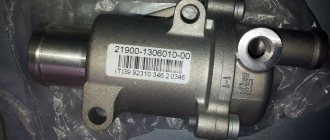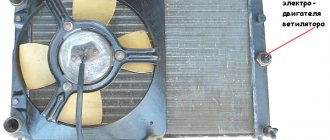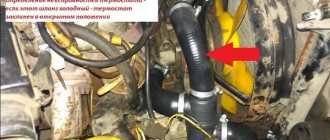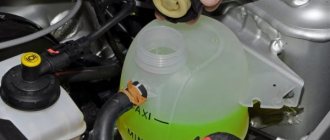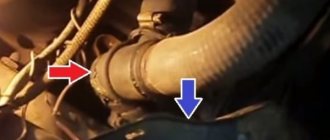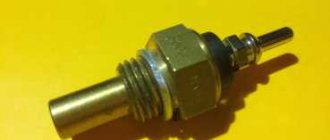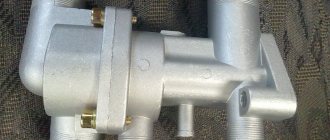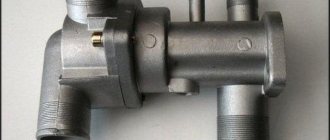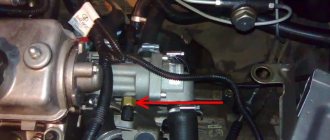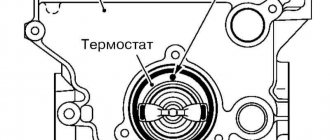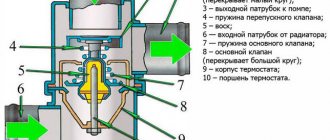A car thermostat for Lada Priora is a very small part that makes a big contribution to maintaining the temperature of the car. No matter how hot the car engine gets, its goal is to reduce the temperature by circulating fluid. The price of a standard thermostat is not high; as a rule, it costs around 500+ rubles. Replacing the thermostat of a Lada Priora car is a mandatory procedure if the car gets hot. In this case, it is necessary to change the thermostat, otherwise the engine will overheat. The part has analogues, but the standard part is the most effective. The Prior has 16 valves, replacement is a little more difficult, due to the fact that it is difficult to get to the antifreeze drain cap. The thermostat of the Priora car saves the engine from overheating. The part comes in 2 types: 1 - opens at a temperature of 92 degrees, 2 - at 95.
The thermostat on the Priora is a very simple device - what is most often damaged is what is inside: the cylindrical sensitive element. It is filled with a wax-based substance and therefore takes the ambient temperature well. The cylinder is surrounded by a spring, which is attached to a valve that tightly separates the small and large circles of circulation of the cooling system. When the material in the cylinder warms up to engine operating temperature, the spring expands and “pushes” the valve out. But this does not happen immediately: the valve extends fully only at a temperature of 103 degrees Celsius.
When the cooling effect of the liquid is achieved, the temperature (already reduced) is transferred to the filling of the cylinder, after which the spring is slowly compressed and the valve moves down. Thanks to the funnel effect, the coolant “drains” faster, and its volume in a small cycle remains unchanged - this is how the cooling system works.
The thermostat on the Priora is installed at the factory with the expectation that the engine will operate exclusively within the maximum permissible temperature. Its design is such that the thermostat (or rather, its valve) is designed to open at a temperature of about 98 degrees Celsius. An open valve provides a path for coolant into the radiator so that it cools even more - to an acceptable temperature - and circulates again, only this time in a large circle.
The factory thermostat of Lada Priora looks like this
Thermostat of the Lada Priora car
A thermostat is a device that allows the engine to maintain a normal temperature.
It is this device that allows you to quickly warm up the engine, as well as the interior of the car, even in the most severe frosts, and in the heat, prevent overheating of the internal combustion engine. It also provides the opportunity to reduce toxic emissions and effectively use fuel consumption. The thermostat on the Priora is directly involved with antifreeze - coolant. Initially, when the engine has just started, antifreeze is used only in the OD jacket, as well as in the stove. But when it warms up to operating temperature, the liquid enters the radiator, which, together with the fan, allows the engine to maintain a normal temperature and not overheat at the right time.
How to check for functionality
If all the described actions are not enough to determine the condition of the part, you can resort to experiment. As written earlier, to start working the part you need to feel the temperature of about 93-95 degrees. Why not replace the coolant with water?
The experiment can be carried out anywhere there is a kettle. After pouring approximately 300 ml of boiling water into a cup, you will have to wait 2 minutes, and then lower the “test person” into hot water. If it is working, then you can clearly study the principle of its operation. The rod of the part will begin a kind of movement, and the valve will rise to open the fluid communication through the large cycle.
Replacing the thermostat is not the easiest repair operation, but it is necessary so as not to “boil” in a traffic jam. It all depends on the choice of part and priorities. If you are too lazy to change it on time, engine wear will increase and, accordingly, its life will decrease.
The right choice and replacement of the thermostat on Priora
The cooling system of a car is one of the main systems that ensures the possibility of its operation. The thermostat, again, is an important component, and its failure can sometimes lead to significant costs.
How to replace a thermostat
Will the Priora allow you to save the family budget? What remains for our client to do as usual is that when this device does not work, the engine may overheat. Everything increases wear on the motor and, therefore, will lead to serious damage.
The cost of a thermostat for Priora is low. Therefore, it is better to change it every two years. Knowing how to change the thermostat on a Priora, this can be done at home. But there are some peculiarities. It would not be superfluous to conduct a little theory to determine which thermostat on the Priora is better.
Possible problems
Over time, the thermostat of a Priora car wears out and can be damaged. Since every time the car is started it is put into operation, the more often the car is in working condition, the more it is susceptible to breakdowns. As a result, it stops changing position and, in a broken state, takes either an open or closed position. This can be affected by mechanical damage, as well as loss of thermostat properties when the device ceases to control the temperature. It is possible that the valve will not close completely due to damage to the rubber gaskets. It is dangerous to operate such a car, so if it breaks down, it is recommended to replace the thermostat on the Priora with a new one.
The Lada Priora has 16 valves; when the device is not working, the following symptoms are noticeable on the car:
When the internal combustion engine constantly overheats, although the device is operating in normal mode, it is possible that the coolant is not passing through the radiator.
Due to coolant leakage, the device stops responding to temperature changes, and because of this, the engine will take much longer to warm up. If coolant gets on the element responsible for temperature control, the valve will open a little earlier and because of this there will be an oversupply. Thus, the cooling system may break down, and the engine will operate at higher speeds.
If the internal combustion engine starts to stall, then due to constant vibrations the coolant can come out and because of this the valve stops functioning.
Fault Prevention
To avoid aggressive deposits and extend the life of the unit and its components, use only high-quality antifreeze and replace it from time to time. When draining the cooler, take a closer look at the condition of the liquid. If the drained antifreeze has a cloudy composition, the presence of flakes or other signs of contamination, this indicates that the system needs to be flushed. In addition, it is recommended to monitor the condition and tightness of the system’s connecting nodes.
Signs indicating malfunctions: - difficult, long engine warm-up; — quick warm-up of the internal combustion engine.
It is important to monitor which thermostat is installed on the Priora and monitor its current technical condition.
How to solve a problem
Depending on the terrain in which the car is operated, it is necessary to choose which device is best to install on the Priora. If the installed device is suitable according to its parameters and characteristics, but the coolant exceeds the permissible values, then it is recommended to replace it with a similar spare part that has a higher temperature threshold for opening the valve. This approach is recommended for those who drive in mountainous areas or forests.
It happens that antifreeze stagnates in one place and this causes a plug to form. In this case, it is necessary to break through it. This can be done using a regular screwdriver.
If the valve opens prematurely, it is possible that the spring on the thermostat is weakened. In this case, you can tighten it or replace it with a new one.
When warming up the engine for a long time, it is best to check the rubber bands first. It is possible that the device is locked in the wrong position and will need to be secured in the correct position to normalize the air valve.
If the valve functions normally and opens on time, but the engine constantly overheats, then you first need to check the antifreeze level, as well as the possibility of plugging due to stagnation. It is possible that the radiator has stopped performing its functional duties and will need to be replaced. The problem may also lie in the fan or cooling pump. It is necessary to check their functionality and replace if necessary. The last thing that can interfere with good cooling is a dirty system. In this case, it is necessary to clean it.
Examination
Since problems with the device can arise at any time, the driver needs to know how to check it even in situations where it is not possible to get to a car service center.
The easiest way to check the thermostat is to leave it on. To do this, the internal combustion engine must be cooled down. We start the engine and at this time we need to touch the pipe, which is attached to the radiator. During the first few minutes, the radiator is not yet functioning, so the pipe should be cool. After this, wait until the engine warms up to operating temperature. Next you need to check the same pipe, it should be heated.
If the tube remains cold, then it is worth looking at what thermostat is used and replacing it with a similar one.
If the pipe heats up almost immediately, the engine will operate at lower temperatures. This problem is not critical, but because of this, gasoline consumption increases.
There is also a second way to check the device by dismantling it.
Before dismantling, you need to drain the antifreeze into a pre-prepared canister. After this, remove the thermostat, which is installed behind the pipe. We take the device and put it in a pan of water and put it on gas. At the same time, it should not come into contact with the walls. We lower the thermometer into the water and wait for the water to heat up to the operating temperature of the motor. When the temperature readings reach the required value, make sure that the valve changes from the closed position to the open position. If this does not happen, it is recommended to install a new device.
Replacing the thermostat on a Priora is not a complicated process that does not require special skills and can be diagnosed at home using improvised methods.
To replace, we need a Phillips screwdriver and a 10mm wrench to loosen the clamps, a 5mm hexagon, a hose, a watering can, a 5 liter bottle to drain the antifreeze, and a 1 liter bottle when unscrewing the far pipe. The leak will come from two places.
To make it easier to carry out all manipulations, remove the air filter housing (AF), take a slotted screwdriver to remove and return the rubber bands to the attachment points of the air filter housing. Next, simply unscrew the fastening nuts.
Before installing a new thermostat, check it using the methods indicated above; assembly is carried out in the reverse order.
But for more accurate diagnostics, it is recommended to contact specialized service centers that will perform their work efficiently and provide a warranty period for them.
Replacing the thermostat on a Priora - instructions
The replacement of the thermostat begins with the fact that the car must be driven onto an overpass. It’s easier to describe further steps step by step:
Open the hood, unscrew the cap (blue) of the expansion tank. Remove the engine protection;
- Get down under the car. Find bolt 13 - this is a plug for draining the coolant. It is not surprising that it is more difficult to get to it on a sixteen-valve engine than on an eight-valve one - after all, the design has changed. Take your time to remove the plug;
- Place a container (preferably a basin with a volume of at least 5 liters) under the plug, and only then unscrew it. Wait until all the antifreeze has drained, then tighten the bolt back. Check it several times, namely: tightness;
- Go up the overpass, and under the hood, at the top right above the engine, find the required part on the cylinder head. Using a Phillips screwdriver, unscrew the screws of the clamps holding the pipes and remove them;
- Using a hexagon, remove the thermostat cover bolts, and then the part itself. This element needs to be removed, but do not try to change the thermostat as quickly as possible - pay attention to the connection groove. It contains a rubber gasket, it can be cleaned of dirt and covered with automotive sealant;
- After the work has been done, you can install a new part in place of the old one, tighten the cover bolts and finish the work - put the pipes on the part, tighten the clamps (you can even put on new ones), pour sealant into the joint between them;
- Pour coolant into the reservoir. If a couple of days after the repair the machine consumes some liquid, this is normal - you just need to top it up to the normal level. Start the engine when warmed up (to about 75-80 degrees). At this time, check the integrity of the structure. Violation of tightness is unacceptable;
- If everything is in order, all that remains is to put back the engine protection and close the hood;
Replacing a thermostat on a Priora with a 16-valve engine is a little more complicated than on a Priora with an eight-valve engine. But, nevertheless, it can introduce the car owner to the route to the nearest overpass or pit, which will help out more than once - no one can rule out a breakdown.
Signs indicating a malfunctioning thermostat
How to check the operation of the thermostat in a car yourself
The car's cooling system contains a liquid whose temperature can fluctuate over a wide range. To control these fluctuations in a car, there is a special mechanical element called a thermostat. This device copes with 2 functions - it prevents overheating of the power unit and allows a quick start of the engine. After some time, the element wears out and becomes unusable. This has a negative effect on the engine. In order to identify such a moment in time, you need to know how to check the thermostat, which is carried out directly on the car. Then, if signs of failure inherent in this element are identified, it is possible to dismantle it and further test it.
Purpose and design features of the thermostat
The thermostat is designed to block the circulation of fluid through the cooling system until the car engine is completely warmed up in order to speed up this process and further maintain the required operating temperature.
Thermostat operating principle
is based on the melting of artificial wax placed in a small cylinder in the direction of the motor. Wax melts at a temperature of at least 80 degrees. At the same time, it expands, increasing in volume, due to which it squeezes the locking pin out of the cylinder, unlocking the thermostat valve and restoring circulation.
Checking functionality manually
To make sure that the thermostat is the cause of engine overheating, do the following:
- Start the engine and wait until it warms up to operating values (85-90 degrees).
- Open the hood of the car and touch the radiator pipe. If its surface is warm or hot, this indicates problems with the cooling system. The fact is that a working thermostat begins to supply coolant in a large circle after the internal combustion engine heats up above 95 degrees. This was done in order to ensure the fastest heating of the engine to operating mode. After the valve begins to operate, the lower pipe heats up.
- If you notice that when the internal combustion engine heats up slightly, the pipe heats up, the reason is a faulty thermostat.
- Please note that in some cases the movement of cooling fluid is hampered by a faulty water pump, which is also a good idea to check.
Causes of thermostat failure
The most important sign of a thermostat failure is a lack of circulation in the engine cooling system, which leads to overheating.
There can be many reasons why a thermostat may malfunction, but the most common problem is corrosion eating away at the cylinder and locking pin, causing fluid flow to not completely stop in any valve position.
In such a situation, it will be much more difficult for the engine to warm up, and it will take much longer than in normal mode. If, on the contrary, the thermostat constantly remains closed, the engine quickly overheats, which leads to a complete inability to continue driving or more serious consequences, such as thermal deformation of the cylinder block and expensive engine overhauls.
When the coolant temperature indicator is on the verge of overheating, despite the fact that one hose is hot and the other is cold, we can most likely say that the thermostat valve is stuck closed and the liquid is not passing through the radiator.
Features of cooling system malfunctions
The efficiency of the structure primarily depends on the level of antifreeze in the system and its condition (this liquid has a certain resource, usually up to three years or up to 50,000 km). The main sources of system malfunctions are the thermostat, radiator and electric fan, as well as the water pump, the principle of operation of which is described above.
The radiator most often becomes the source of antifreeze leakage. Accordingly, the liquid level in the system drops, and there is not enough of it for effective heat removal. The motor begins to overheat. It can also be clogged with garbage. And if water is used instead of antifreeze the old fashioned way, scale may form.
The consequences of a faulty water pump are much more serious. In addition to antifreeze leakage, the circulation of coolant in the system may stop and, as a result, the engine will quickly overheat. The worst case scenario is bent valves due to a broken timing belt.
The next common malfunction is burnout of the cylinder head gasket or deformation of the cylinder head of the internal combustion engine system. This leads to coolant entering the fuel combustion chambers. The same thing can happen if cracks appear on the cylinder block.
Coolant leakage is most often associated with loss of tightness of the connecting pipes, because over time, the material from which they are made hardens and wears out, as a result of which it cannot work properly.
On a Priora, a lot depends on the computer, and a faulty coolant temperature sensor can give incorrect readings. For example, if the ECU receives underestimated performance, the engine will begin to overheat. Otherwise, the fan will be constantly on. On the other hand, often the cooling system sensor does not transmit any readings at all. Then the ECU switches the operation to emergency mode.
Causes of malfunctions
Why do problems occur in cooling systems? The following factors usually play a role:
- natural wear and tear of components;
- mechanical damage;
- operation of the engine in violation of maintenance rules;
- failures in the electronics (for example, an error in the Priora coolant temperature sensor).
In addition, breakdowns can be caused by low-quality spare parts and coolant, mixing antifreeze of different brands, and unqualified repair work. If problems occur with the cooling system, they should be addressed immediately. In some cases, ignoring problems will cause complete failure of the power unit.
This can happen due to coolant getting into the oil sump or engine overheating due to low fluid level (a faulty thermostat can also be one of the reasons). In turn, operating an overheated motor leads to its jamming. Considering these facts, we can conclude that the cooling system must be constantly monitored. The antifreeze level should always be normal; the coolant that has exhausted its life should be changed in a timely manner.
You can notice problems yourself; for this there is no point in contacting a car service.
And repair work on replacing and servicing the cooling system of the Lada Priora can be done with your own hands. There is nothing complicated about this. With the exception, perhaps, of the pump, where you will have to deal with installing a timing belt. In this case, it is better for beginners to entrust the procedure to professionals. Depending on the region, the cost of such services does not exceed 1,500 rubles, and this is the most expensive system repair operation; the rest are priced less.
Determining the functionality of the thermostat
In order to determine whether a given part works, you don’t even need to know where the thermostat is located. It is enough to simply warm up the engine, but do not bring its temperature to the red line. Then turn off the engine and open the hood, look for the upper and lower radiator hoses there. Simply touching them is enough. If one hose turns out to be hot, while the other remains cold, most likely the thermostat valve did not open when the engine was running, which means it is not operational and needs urgent replacement. The thermostat circuit is quite simple, the device is cheap, so there is no point in trying to repair it - changing it is much easier.
Winter thermostat 92 degrees Lada Priora, 2110. Thermoelement 21082.
Shop - thermostat
(385 rubles) (Priora, 10.8 new standard) 6 outlets on a thermos - Alaska antifreeze 3 liters ((220 rubles) there was antifreeze and let it be) - thermostat gasket (from 2-4 rubles) (placed between the engine and the thermos ) -Prior thermostat studs 2 pcs.
Just in case (size M845), well, in general, there is one lower small one and the other upper one M845 - the expansion barrel pipe from the VAZ 2112 (the factory one is short, hard and without threads, and from the 12th it is soft, thicker and one layer of threads, everything fits perfectly ) in principle, it’s not difficult to install everything. I’ll tell you how I drained the antifreeze (the garage is not my wooden floor, they said not a pack), but time passed and I had to figure out how to drain it. And the first thing that came to mind was that everything was going fine, but the hose on the thermos on the stove didn’t want to come off, it stuck, I picked it up with a screwdriver and it started peeling off like the bark of a tree shorter than the khan (Buy a SPARE just in case), I DIDN’T BUY FROM A FRIEND, I ended up with IT'S LUCKY FOR ME IN THE CAR)))) I took it all apart, cleaned the place for the gasket, changed the stud since mine had come out and was all rusty.
I smeared a thin layer of lithol on the space under the gasket on the engine and thermos (a good remedy for leaks in some cases is better than sealant) and screwed the thermos on. The radiator hose fits perfectly
but from the radiator the little one is a little short, but that’s how it dresses and holds up, I don’t think anything bad will happen. The pipe going from the thermos to the pump intake pipe fits perfectly! it all depends on the pipe itself; I have bent and straight ones, and I don’t need to change the pipe.
Next, I installed the expander hose, cutting off 5-10 centimeters from it somewhere (you need to look on the spot) and lastly there was the stove pipe, I’ll tell you this is such crap, they are semi-plastic! tough! without threads, I personally didn’t like it, well, there was no choice, since it was night and there was nowhere to find a replacement for the factory one. I collected everything, filled it with antifreeze and started it. And then the VENELLATOR JUST TURNED ON! I turned it off again, started it again, and it turned on again. In short, like 5 times, well, what did I come up with under the torpedo where the brains are, there are 3 relays and 3 relays, but I don’t know what is responsible, in general, on a stalled car, I took out the relays one by one and started it up, it turned out that the statret did not work (there is a starter relay and a relay for them) then gasoline.
Source: womaninred.ru
Design Features
A thermostat is a small mechanical valve. The device regulates and determines the temperature of the coolant in the engine system and is responsible for the quality of warming up the car engine. The structure consists of the following elements:
The opening temperature of the thermostat depends on the characteristics of the car model, as well as on the capabilities of the device.
This video will help you get acquainted with the principle of operation of the thermostat:
Types of modern thermostats
Today, car manufacturers equip engines with different thermostats. There are several main types of these useful structures:
Signs and causes of failure
Any malfunctions in the operation of the device have a detrimental effect on the operation of the entire vehicle. The main symptom and cause of the malfunction is considered to be corrosion. It gradually corrodes the locking pin and cylinder. A sign of a non-working thermostat in this case is a pulsating, continuous flow of cooled liquid. It does not matter what position the valve is in. Signs of a faulty thermostat also include:
Due to breakdowns, the car cannot start normally. You should understand why the thermostat is not working and find out the signs of unit failure as soon as possible. Violation of the temperature regime has a detrimental effect on the engine: it quickly wears out and becomes unusable.
How to replace the thermostat on a VAZ 2170-VAZ 2172?
Removal: 1) First drain the coolant, because it will interfere with operation and you are unlikely to change the thermostat at all if the liquid is poured into the cooling system (How to drain the liquid, read the article: “Replacing the coolant on a car”), but when the liquid will already be drained, use a screwdriver to unscrew the two screws that secure the clamps of the pipes (One clamp for each pipe, see photo below) and then disconnect the pipes from the thermostat body (Only two pipes are connected to the body, if you look carefully, you will quickly find them ), well, after the pipes are disconnected, unscrew the three nuts with a hex wrench (see small photo, for clarity, the thermostat housing in the photo has already been removed) that secure the thermostat cover and then remove the cover from the housing (it is installed on the cover thermoelement which needs to be replaced periodically).
2) Now you will have to remove the thermoelement itself from the cover, to do this either with your hands or carefully with pliers (it’s more convenient to use them), press on the thermostat (see small photo) and, overcoming the spring force, press the thermostat fixing plate down (the thermostat itself will sink at this time) and turning the plate and the thermostat itself at the same time, remove it, as it will come out of the grooves with which the thermostat plate is connected.
Note! After removing the cover, check on it or in the place where it fits the gasket, which must be there; if it is not there, then buy a new one; for clarity, it is shown with an arrow in the photo below:
Installation: The new thermoelement is installed in the reverse order of removal; when installing, make sure that its plate is properly engaged with the grooves, then install the cover with the thermoelement and finally pour coolant into the cooling system and, to eliminate future problems, lubricate the pipes inside with sealant and Be sure to check the thermostat before installing it on the car.
Note! Fill in the coolant correctly, all the details and subtleties are described in the article on replacing the coolant (the link to this article is given above), in addition, when everything is installed, start the car and see how it works, and also check if the hoses are leaking, otherwise Usually they leak and to ensure that this doesn’t happen 100%, they are generally replaced when the fluid is drained with new ones and in addition they are lubricated with sealant and then you definitely won’t have any problems with the pipes!
Additional video clip: Watch an additional video that will give you a more detailed understanding of how the thermoelement is removed from the car and how it is replaced with a new one, the whole procedure was performed on a VAZ 2114, on a Priora, essentially everything is done the same way.
Note! You can see how to check the thermostat in another video, which is also located below:
Source: avto-idea.ru
Methods for determining device malfunction
There are several ways to identify errors in the operation of the thermostat and eliminate the more serious consequences of its malfunction. For example, turn on the engine for a couple of minutes. If during this time the hose connecting the thermostat and the radiator manages to heat up, it means that there is a problem with the valve of the device. A hose of good design remains cold when the engine warms up briefly.
There are several ways to identify a thermostat malfunction, but it is best to seek help from a car mechanic.
There is another method to identify problems. The structure along with the thermometer is lowered into a special glass vessel with cold water. During the process of heating the water, it will become clear whether the unit is working properly or not. Sometimes a diagnostic scanner is used for such purposes.
To identify serious damage, it is recommended to seek help from specialists. They will help you resolve the problem in a timely and efficient manner.
